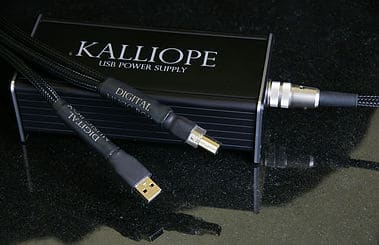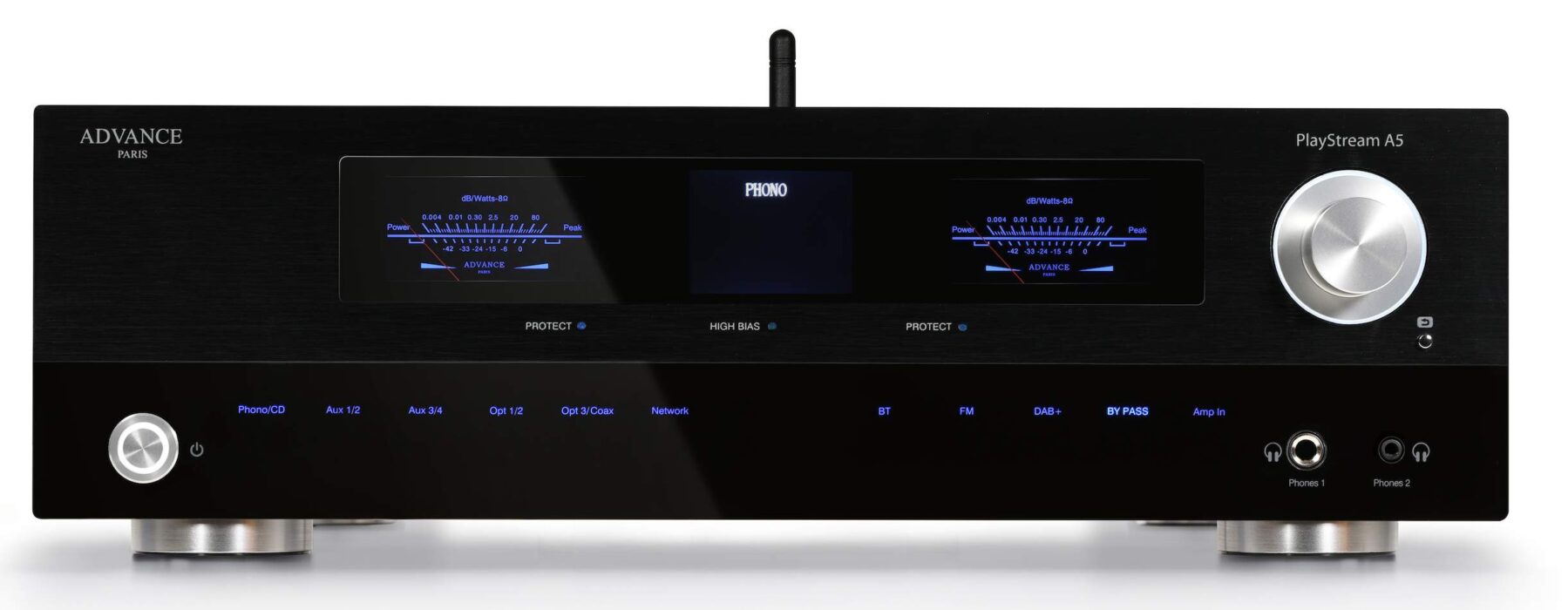The Article
Digital Music Box Kalliope powered USB unit: Should You Kalliope?
3rd October 2015

By gum, another powered USB unit has been released! Paul Rigby reviews the Digital Music Box Kalliope
The powered USB unit takes the job of powering the USB port away from a host computer (which only has a cheap and nasty suite of components to do the job, anyway) to improve the overall sound quality of a DAC-powered digital file.
It was only recently that I reviewed Astintrew’s Powered USB which performed very well. So well, in fact, that it was awarded a well-deserved Groovy. How would the Kalliope, priced at over £300 more, perform?
What we have here is a 5V, fully regulated, linear power supply. Included, say Digital Music Box (DMB), for improved sonics and to avoid polluting the mains with a switch mode supply, degrading performance of your other analogue components. The Kalliope power supply unit is designed to be left on and doesn’t have a attendant shining and, say DMB, adding noise. That said, you never know if the thing is on and working properly. Some sort of indication would have been welcome.
The separate digital audio and power supply cables only come together at the plug where they meet at the DAC. They are separately screened DMB say that too much screening kills dynamics, air and life, too little introduces noise or a grey opacity.
The signal cables are 0.5mm diameter pure (99.9999%) silver inserted with a PTFE dielectric, twisted at a controlled rate to reject RF. High quality gold plated USB plugs are also used. The featured solder is high quality with a small amount of gold added. The company preferred the sound of this to regular silver solder.
SOUND QUALITY
Putting the Kalliope into the digital chain was interesting and enlightening. Powering The Sugababes’ track, Blue, was interesting. The fact that this track is fundamentally broken remains an issue. You can hear were excessive peak limiting compression has fatally damaged certain areas of the presentation. After running it through the Kalliope, though, I have to admit that I have never heard this track play with such maturity and confidence before and I include some pretty expensive CD players in that list.
To begin, the bass sounded darker, fuller and appeared to have stronger rounded edges, boundaries that gave the lower frequencies more substance. After the bass intro, the vocal impressed with a new sense of stability and conviction. The girls seemed determined to say what they wanted to say, there was a new resolution in their voice.
This enhanced emotive force was helped by a sense of focus that enabled me to hear more of the lyrics. That is, the previous blurring of the midrange that sometimes made the words unintelligible was largely removed. Now I had a sense of, “Oh, that’s what she’s saying!” at certain moments. At some parts of the song, it was as if I was listening to the track for the very first time. That focus was spread throughout the soundstage which lowered the sound stage itself, further to the floor but also allowed a tremendous instrumental separation and the enhanced timing of each improved the tonal accuracy.
Secondary percussion benefitted most from the new focus and clarity, providing a more complex mix. Now, there seemed to be much more going on within the song itself.
Playing the rather gloomy, classical piece, From Let Us Garlands Bring from Marianne Beate Kielland on vocal and Sergej Osadchuk on piano via 24bit/96kHz, the sense of focus was continued, especially during the female vocal performance which no longer had a sense of upper midrange bloom on crescendos. The vocal, in addition, offered a slightly more 3D effect in terms of the centre of the soundstage that gave the entire performance an epic feel. The accompanying piano was locked down in its preference for lower frequencies. That is, there was less wavering during the bass sequences. It had a greater security within this bandwidth, in fact.
Finally, the blues track, Big Bad Girl from the blues shouter, Harry ‘Big Daddy’ Hypolite (24bit/96kHz) was revealing. One of the ‘problems’ of this track is Hypolite’s strong shotgun voice. He shouts those blues lines right at you and they tend to obscure a lot of what else is going on in the track and in his voice, to be honest. After all, this is an ageing black blues man. His voice has that vintage timbre that has produced various tonal qualities. With the Astintrew, the strength of his blues shouting often blurred out everything else. Putting the Kalliope in place didn’t lessen that power but it did focus it which meant that you could, for the first time, look around the edges to see what was laying behind. Hence, the voice sounded tonally more realistic. More like a human voice and less like a sampled shout. This meant that the Hypolite delivery was interesting and nuanced. Similarly, his acoustic guitar strumming produced variation in its presentation. You could hear emphasis in strumming and the complex finger picking was impressive because you could hear where his fingers were roaming around the guitar.
CONCLUSION
I have always liked the notion of sourcing digital music from a SSD rather than a CD which is susceptible to jitter and other forces. The problem is that audiophile music and computers do not mix. The idea of taking the USB port, effectively, out of the computer has isolated one of the main trouble spots for computer-based music sourcing. The result, in terms of the Kalliope, is a triumph.
For the first time, I’m seeing a computer as a serious music delivery option. You may see the price of the Kalliope, at least initially, as high, even shockingly so but, after using the thing, realising what it does and why, I’m sure that you will agree with me that it is not only necessary to make a computer source for digital music actually work but, compared to CD players of a similar price (even factoring in the price of a SSD-powered laptop), the Kalliope is a bargain!
DIGITAL MUSIC BOX KALLIOPE
Price: £1,000
Website: www.thedigitalmusicbox.com
Tel: 01202 240 944
Good: focus, tonal reality, low noise
Bad: nothing
Rating: 9
REFERENCE
Macbook Pro (with SSD)
Tellurium Q USB cable
Astintrew DAC 1
Aesthetix Calypso Pre
Icon Audio MB845 Mk.II monoblocks
Quad ESL-57 speakers with One Thing upgrade



